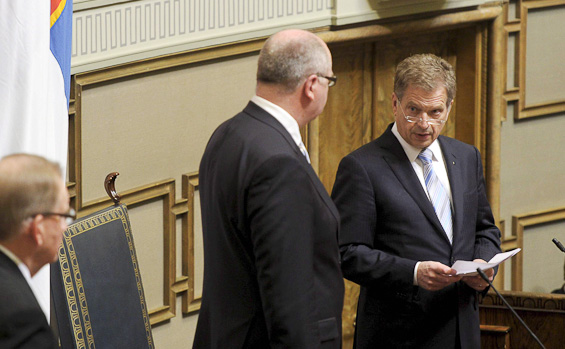In his new year’s speech Finland’s President Sauli Niinistö threw
petrol on a small fire which had already been burning for a while. In
order to save the country’s competitiveness, he said, employees as well
as bosses should ease off on their salary demands.
He led by example. Ahead of his speech, President Niinistö had asked
the Finnish parliament to prepare a change in legislation which would
lower the President’s wage to a 2006 level, or from €160,000 a year to
€126,000 – a more than 20 percent cut.
Niinistö’s predecessor, Tarja Halonen (Social Democratic Party),
says that she would have found it difficult to suggest a reduction in
wages because of her trade union background.
The speaker of the parliament on the other hand, Social Democrat
Eero Heinäluoma, felt even MPs could take a pay cut.
Delicate timing
Centre-right politician Niinistö’s suggestion came at a delicate
time, or perhaps it was timed that way. Employers were resenting the
collective agreement of the autumn of 2011, which binds them to salary
increases which might appear unwise in the current economic climate.
The current government, which came to power in 2011, also based its
programme on fairly optimistic forecasts.
Niinistö’s speech could therefore be seen as support for the
employers.
The new Chairman of the Confederation of Finnish Industries, Ilpo
Kokkila, had already said wages should be cut rather than raised.
Niinistö’s political party colleague and former minister of economic
affairs, Jyri Häkämies, suggested extending the working week by two
hours – with no increase in wages. Both also said they were willing to
take a pay cut themselves.
Betrayal
Employee representatives, on the other hand, feel employers have
betrayed their promise of introducing three training days.
Meanwhile the debate over an increase in Finland’s pensionable age
carries on unabated.
Trust between the parties is basically at an unprecedented low.
Trade unions have refused any renegotiating of the present agreement,
which runs out in a year’s time, and want to extend it with another
year. They have public opinion on their side: just five percent of
Finns are willing to take a pay cut according to an opinion poll
commissioned by business weekly Talouselämä in January.
And for now it seems employers have given up their fight for lower
wages. What employers are proposing is in reality an internal
devaluation. Finland is part of the Eurozone and unlike other Nordic
countries it cannot adapt cost levels by depreciating the value of its
currency. In Southern Europe the same adaptation process is taking
place, only on a much larger scale than in the Nordic region.
German role model
Those advocating pay cuts point to Germany as one Euro country which
has managed the balancing act of adapting its labour costs despite the
fixed exchange rate.
Since 2004, German salaries have risen slower than inflation.
People’s purchasing power has fallen by four percent between 2000 and
2010. Wage development has also been negative, wage increases have been
below what was agreed in the collective agreement, partly because of a
major increase in the number of part-time jobs and extremely low paid
jobs.
Still the German locomotive steams ahead despite the fact that most
of the Eurozone has taken a deep dip.
The German example still horrifies trade unions, especially the
system of weakening the collective agreement through the use of
so-called opening clauses. They allow companies to negotiate local
exceptions from central trade agreements.
The first collective agreement with opening clauses was signed as
early as in 1985, but only at the start of the 2000s did German trade
unions seriously begin to feel the pressure to agree to exceptions. Yet
so far lower wages represent just a smaller part of locally adapted
agreements. Much more common have been longer working hours for the
same pay and the abolition of perks, tax credits or bonuses.
Vague promises
In return, the offers from employers have been varied. Often it has
simply been a promise not to shut the business down. Opening clauses
were initially meant to be used to help companies in economic
difficulties, but lately they have been used more as a common tool to
improve competitiveness.
It is not altogether surprising that union representatives look to
Germany with a degree of trepidation. The number of union members there
has been nearly halved in the past 20 years, and the union membership
rate stood at 20 percent in 2011.
Many in both Sweden and Denmark will recognise the Finnish debate on
pay cuts. The recent deal agreed by staff at SAS broke the trend of
steadily increasing salaries in the Swedish labour market.
“The agreement between unions and the SAS airline is unique for the
Swedish labour market. There have been pay increases year on year since
the 1930s,” Kurt Eriksson from the Swedish National Meditation Office
told national radio when the news broke.
“There were pay cuts mainly during the 1920s and 1930s. After that
the negotiations have been about pay increases.”
No trend
Several Swedish companies have also entered into special crisis
agreements with their staff, but this does not yet make up a trend. The
Confederation of Swedish Enterprise has not pushed for lower wages
either, but would probably like to freeze pay at the current level.
Sweden has also seen a more positive economic development than Finland
and Denmark.
Some businesses also fear that the debate over lower wages could
make households overly cautious with their spends, triggering a fall in
consumption. Even though lower wages could help the export industry,
the domestic service industry stands to suffer. Economists agree that
lowering wages is the wrong way to go. Meanwhile moderation is
increasingly put forward as an argument in the run up to another round
of negotiations.





